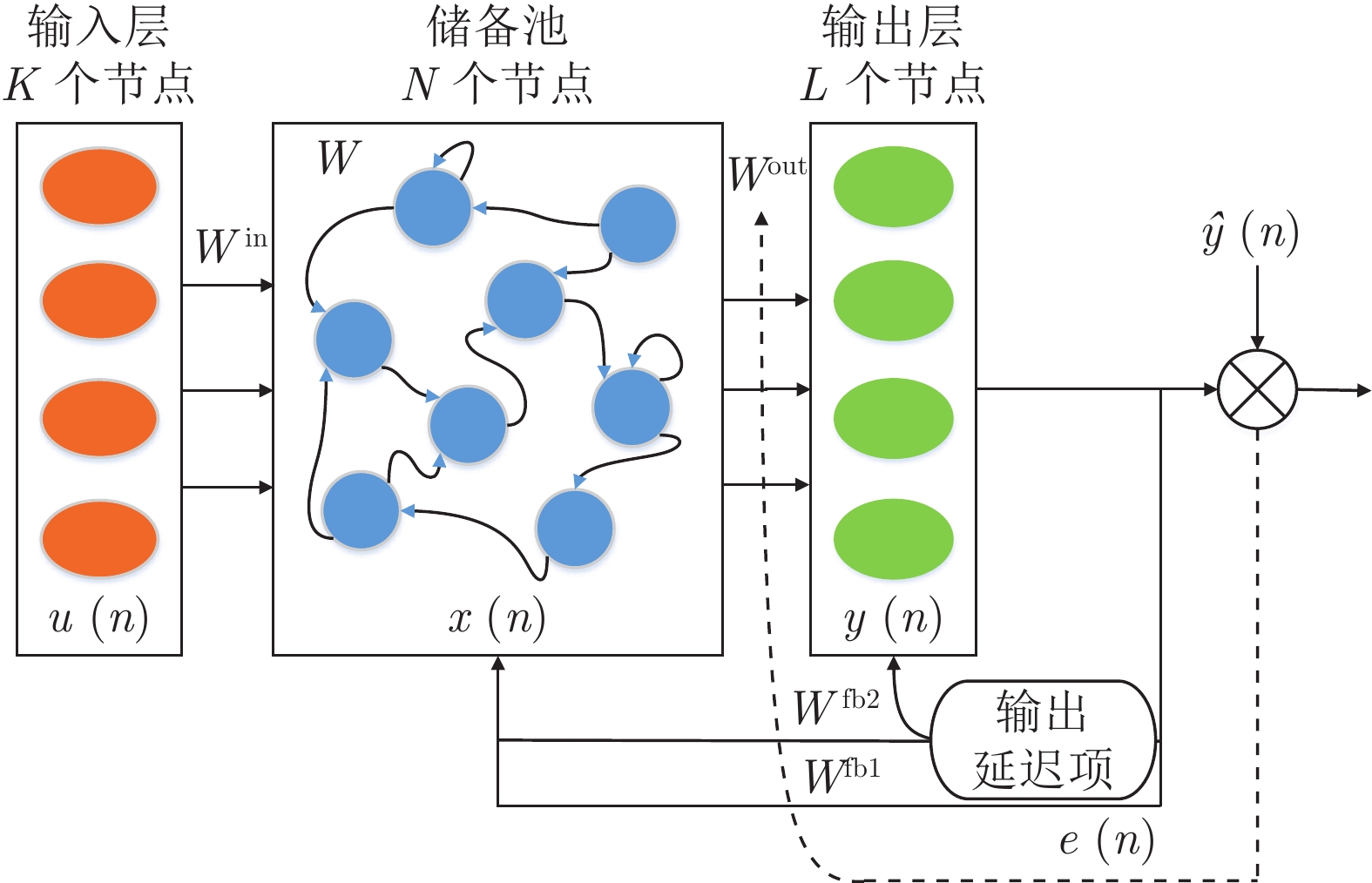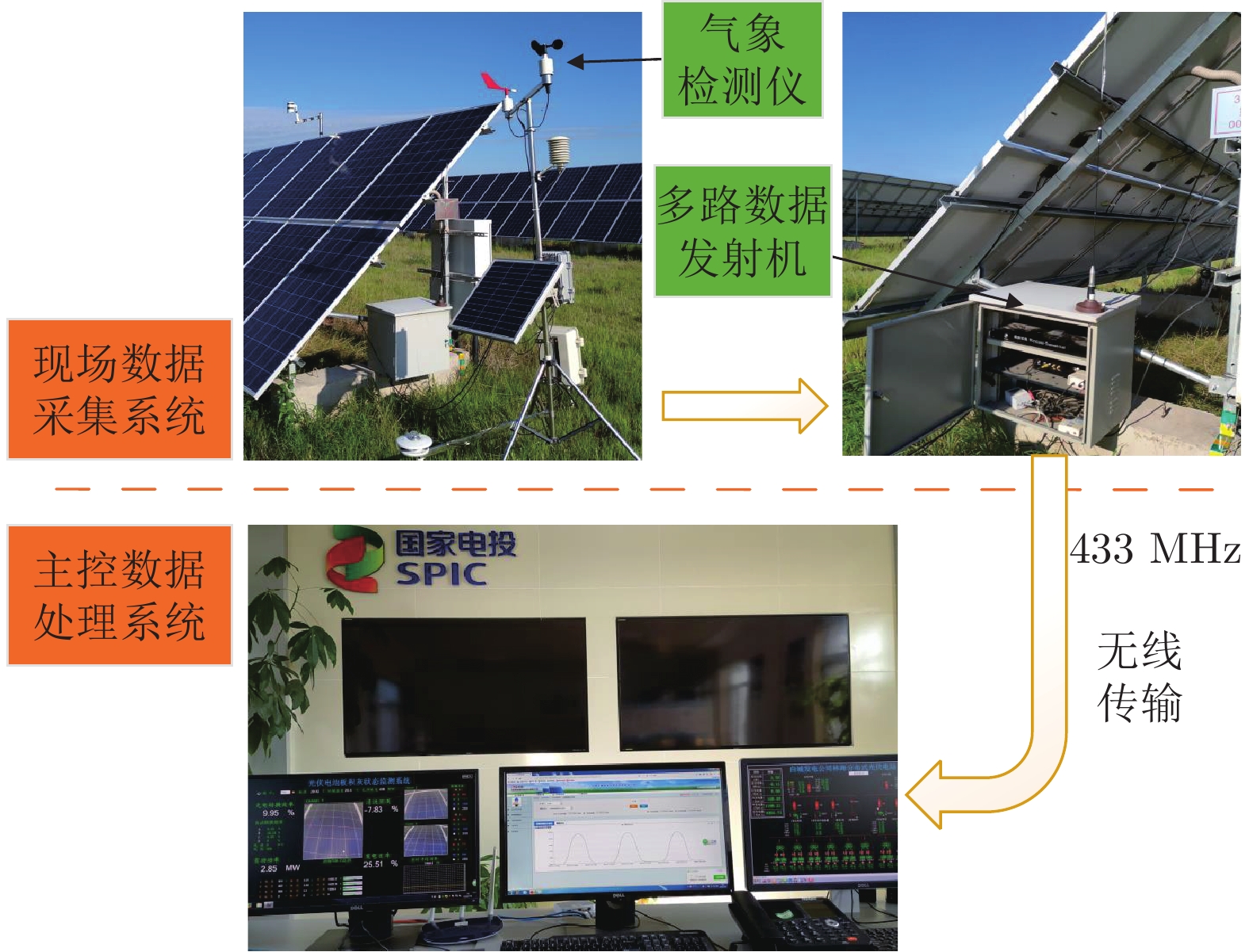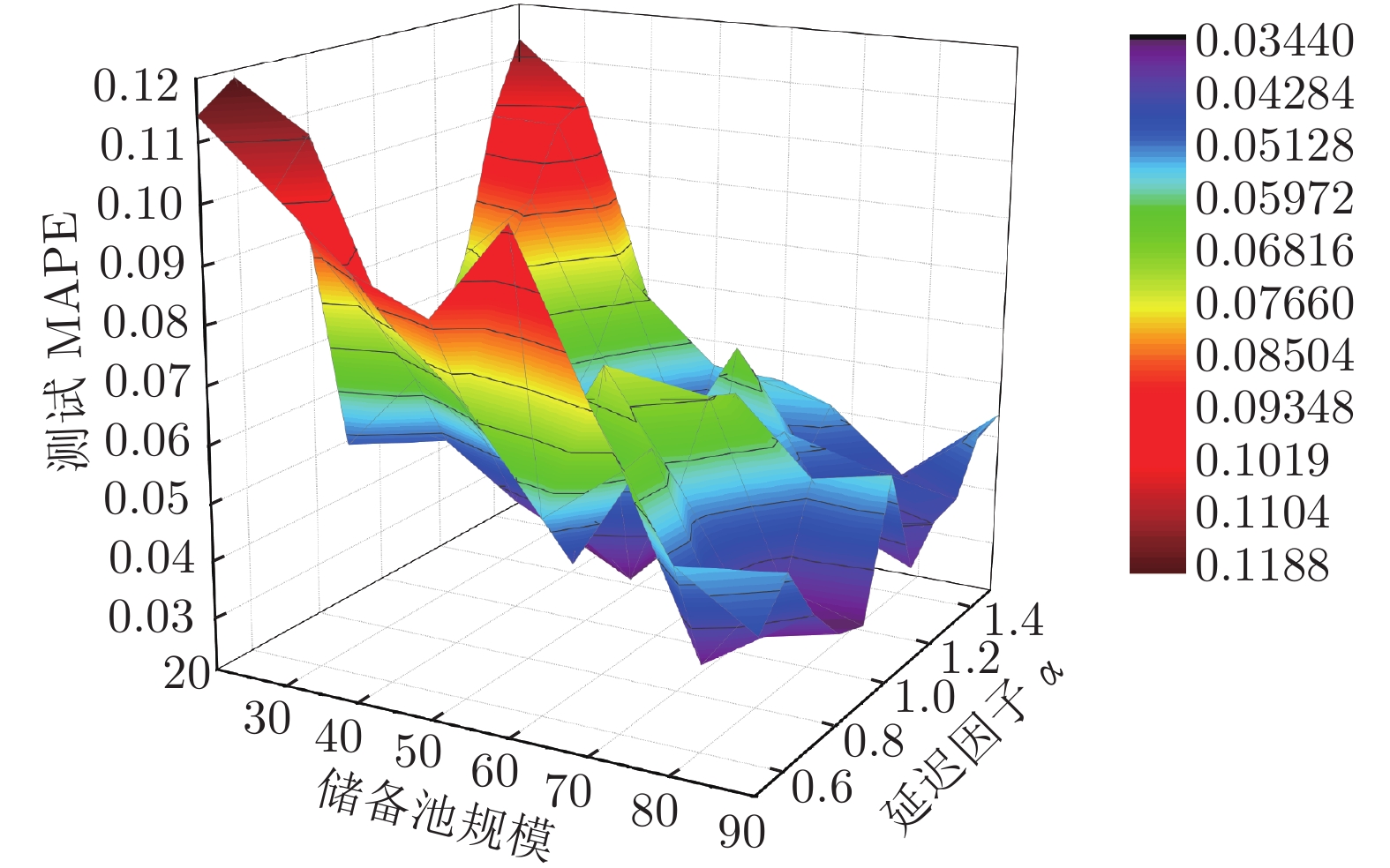Temperature Prediction of Photovoltaic Panels Based on Delayed Echo State Network
-
摘要: 光伏电池温度变化影响光伏系统输出的稳定性, 精准地预测光伏电池板温度的变化趋势, 对光伏系统智能运行具有重要意义. 为了更好地预测温度的变化趋势, 本文考虑了光伏电池板温度的迟滞效应, 将先前的温度输出作为延迟项引入回声状态网中, 提出了一种基于延迟回声状态网的光伏电池板温度预测模型. 给出一个延迟回声状态网具有回声状态特性的判定条件, 使得预测模型能够稳定地预测光伏电池板温度. 同时, 建立了一套光伏多传感器监测系统, 利用该监测系统采集的数据, 训练和验证模型的准确性. 与回声状态网(Echo state network, ESN), Leaky ESN (Leaky-integrator ESN)和VML ESN (ESN with variable memory length)相比, 仿真结果表明, 本文所提出的延迟回声状态网具有更好的预测性能, 平均绝对百分比误差甚至达到3.45%.Abstract: The temperature change of photovoltaic (PV) cells can affects the output stability of PV system, and then the temperature change trend of PV panels can be predicted accurately, which will be significance for the intelligent operation of PV system. In order to better predict the change trend of temperature, this paper takes into account the hysteresis effect of PV panels temperature, and the previous temperature output is introduced into the echo state network (ESN), and thus, an improved prediction model of PV panels temperature based on the delayed echo state network is proposed in this paper. A criterion condition for the echo state characteristic of the delayed echo state network is given, such that the prediction model can predict the temperature of the PV panels stably. At the same time, a multi-sensor monitoring system of PV is established, and the collected data by monitoring system are used to train and verify the accuracy of model. Compared with ESN, Leaky ESN (Leaky-integrator ESN) and VML ESN (ESN with variable memory length), the simulation results show that the Delay ESN has better prediction performance, and the average absolute percentage error of 3.45%.
-
表 1 监测系统记录的数据
Table 1 Data recorded by monitoring system
时间 输入 输出 光照幅度
(W/m2)环境温度
(℃)风速
(m/s)风向
(°)电池板温度
(℃)8:00 585 25.10 2.2 205 34.53 8:15 610 26.50 2.0 224 35.79 8:30 649 26.50 2.1 252 35.62 8:45 665 27.30 2.9 199 38.60 $\vdots $ $\vdots $ $\vdots $ $\vdots $ $\vdots $ $\vdots $ 15:15 699 32.50 2.2 242 45.22 15:30 518 32.30 2.6 242 41.97 15:45 311 31.10 3.2 273 38.62 16:00 159 30.80 2.4 205 34.64 表 2 延迟回声状态网储备池参数
Table 2 The reservoir parameters of delayed ESN
储备池规模 谱半径 稀疏度 (%) 训练样本长度 50 0.82 2 1400 表 3 四种方法的预测精度对比
Table 3 Comparison of prediction accuracy of four methods
表 4 延迟回声状态网不同储备池规模性能分析
Table 4 Delayed ESN performance analysis for different sizes of reservoir
储备池规模 (N) 样本长度 评价指标 (测试MAPE) 20 1400 0.0514 30 1400 0.0495 40 1400 0.0407 50 1400 0.0345 60 1400 0.0352 70 1400 0.0667 80 1400 0.0542 90 1400 0.0571 -
[1] 周孝信, 陈树勇, 鲁宗相, 黄彦浩, 马士聪, 赵强. 能源转型中我国新一代电力系统的技术特征. 中国电机工程学报, 2018, 38(7): 1893−1904, 2205Zhou Xiao-Xin, Chen Shu-Yong, Lu Zong-Xiang, Huang Yan-Hao, Ma Shi-Cong, Zhao Qiang. Technology features of the new generation power system in China. Proceedings of the Chinese Society for Electrical Engineering, 2018, 38(7): 1893−1904, 2205 [2] 赵志刚, 张纯杰, 苟向锋, 桑虎堂. 基于粒子群优化支持向量机的太阳电池温度预测. 物理学报, 2015, 64(8): 380−386Zhao Zhi-Gang, Zhang Chun-Jie, Gou Xiang-Feng, Sang Hu-Tang. Solar cell temperature prediction model of support vector machine optimized by particle swarm optimization algorithm. Acta Physica Sinica, 2015, 64(8): 380−386 [3] 徐瑞东, 戴瀹, 孙晓燕. 基于BP神经网络的光伏阵列温度预测. 工矿自动化, 2012, (7): 63−67Xu Rui-Dong, Dai Yue, Sun Xiao-Yan. Temperature prediction of photovoltaic array based on BP neural network. Industry and Mine Automation, 2012, (7): 63−67 [4] Xu R D, Wu J W, Sun X Y. Photovoltaic module temperature prediction with Gaussian process. International Journal of Advanced Mechatronic Systems, 2012, 4(3/4): 187−196 doi: 10.1504/IJAMECHS.2012.051563 [5] Ceylan İ, Erkaymaz O, GedikG E, Gürel A E. The prediction of photovoltaic module temperature with artificial neural networks. Case Studies in Thermal Engineering, 2014, 3: 11−20 doi: 10.1016/j.csite.2014.02.001 [6] 彭飞, 任敬国, 陈玉峰, 辜超, 朱文兵. 计及表面纹理结构的晶硅太阳电池温度预测模型. 太阳能学报, 2016, 37(2): 337−343 doi: 10.3969/j.issn.0254-0096.2016.02.012Peng Fei, Ren Jing-Guo, Chen Yu-Feng, Gu Chao, Zhu Wen-Bing. Temperature predication model for crystalline silicon solar cell considering surface textured structure. Acta Energiae Solars Sinica, 2016, 37(2): 337−343 doi: 10.3969/j.issn.0254-0096.2016.02.012 [7] Sun Y J, Wang F, Zhen Z, Mi Z Q, Liu C, Wang B, Lu J. Research on short-term module temperature prediction model based on BP neural network for photovoltaic power forecasting. In: Proceedings of the 2015 IEEE Power and Energy Society General Meeting. Colorado, USA: IEEE, 2015. 1−5 [8] Sun Y J, Wang F, Mi Z Q, Zhen Z, Sun H B, Lu J, et al. Short-term prediction model of module temperature for photovoltaic power forcasting based on support vector machine. In: Proceedings of the 2015 International Conference on Renewable Power Generation. Beijing, China: IET, 2015. [9] Jakhrani A Q, Othman A K, Rigit A R H, Samo S R. Determination and comparison of different photovoltaic module temperature models for Kuching, Sarawak. In: Proceedings of the 2011 Clean Energy and Technology. Kuala Lumpur, Malaysia: IEEE, 2011. 231−236 [10] Jaeger H, Hass H. Harnessing nonlinearity: predicting chaotic systems and saving energy in wireless communication. Science, 2004, 304(5667): 78−80 doi: 10.1126/science.1091277 [11] Gallicchio C, Micheli A, Pedrelli L. Design of deep echo state networks. Neural Networks, 2018, 108: 33−47 doi: 10.1016/j.neunet.2018.08.002 [12] Gallicchio C, Micheli A. Deep reservoir neural networks for trees. Information Sciences, 2019, 480: 174−193 doi: 10.1016/j.ins.2018.12.052 [13] Chitsazan M A, Fadali M S, Trzynadlowski A M. Wind speed and wind direction forecasting using echo state network with nonlinear functions. Renewable Energy, 2019, 131: 879−889 doi: 10.1016/j.renene.2018.07.060 [14] Matino I, Dettori S, Colla V, Weber V, Salame S. Forecasting blast furnace gas production and demand through echo state neural network-based models: Pave the way to off-gas optimized management. Applied Energy, 2019, 253: 113578 doi: 10.1016/j.apenergy.2019.113578 [15] Matino I, Dettori S, Colla V, Weber V, Salame S. Application of echo state neural networks to forecast blast furnace gas production: pave the way to off-gas optimized management. Energy Procedia, 2019, 158: 4037−4042 doi: 10.1016/j.egypro.2019.01.835 [16] 伦淑娴, 林健, 姚显双. 基于小世界回声状态网的时间序列预测. 自动化学报, 2015, 41(9): 1669−1679Lun Shu-Xian, Lin Jian, Yao Xian-Shuang. Time series prediction with an improved echo state network using small world network. Acta Automatica Sinica, 2015, 41(9): 1669−1679 [17] 许美玲, 王依雯. 基于改进差分进化和回声状态网络的时间序列预测研究. 自动化学报, 2019, DOI: 10.16383/j.aas.c180549Xu Mei-Ling, Wang Yi-Wen. Time series prediction based on improved differential evolution and echo state network. Acta Automatica Sinica, 2019, DOI: 10.16383/j.aas.c180549 [18] 刘颖, 赵珺, 王伟, 吴毅平, 陈伟昌. 基于数据的改进回声状态网络在高炉煤气发生量预测中的应用. 自动化学报, 2009, 35(6): 731−738 doi: 10.3724/SP.J.1004.2009.00731Liu Ying, Zhao Jun, Wang Wei, Wu Yi-Ping, Chen Wei-Chang. Improved echo state network based on data-driven and its application to prediction of blast furnace gas output. Acta Automatica Sinica, 2009, 35(6): 731−738 doi: 10.3724/SP.J.1004.2009.00731 [19] 雷苗, 彭宇, 郭嘉, 彭喜元. 基于先验簇复杂回声状态网络的话务量预测. 仪器仪表学报, 2011, 32(10): 2190−2197Lei Miao, Peng Yu, Guo Jia, Peng Xi-Yuan. Traffic forecasting for prior knowledge based clustered complex echo state networks. Chinese Journal of Scientific Instrument, 2011, 32(10): 2190−2197 [20] 田中大, 李树江, 王艳红, 王向东. 基于混沌理论与改进回声状态网络的网络流量多步预测. 通信学报, 2016, 37(3): 59−74Tian Zhong-Da, Li Shu-Jiang, Wang Yan-Hong, Wang Xiang-Dong. Networks traffic mult-step prediction based on chaos theory and improved echo state networks. Journal on Communications, 2016, 37(3): 59−74 [21] 姚显双, 伦淑娴. 基于回声状态网的光伏发电量预测. 电子设计工程, 2015, 23(22): 92−93, 96 doi: 10.3969/j.issn.1674-6236.2015.22.029Yao Xian-Shuang, Lun Shu-Xian. Photovolatic power generation forecasting based on echo state network. Electronic Design Engineering, 2015, 23(22): 92−93, 96 doi: 10.3969/j.issn.1674-6236.2015.22.029 [22] Yao X S, Wang Z S, Zhang H G. Prediction and identification of discrete-time dynamic nonlinear systems based on adaptive echo state network. Neural Networks, 2019, 113: 11−19 doi: 10.1016/j.neunet.2019.01.003 [23] Yao X S, Wang Z S, Zhang H G. A novel photovoltaic power forecasting model based on echo state network. Neurocomputing, 2019, 325: 182−189 doi: 10.1016/j.neucom.2018.10.022 [24] Li Q, Wu Z, Xia X. Estimate and characterize PV power at demand-side hybrid system. Applied Energy, 2018, 218: 66−77 doi: 10.1016/j.apenergy.2018.02.160 [25] Jaeger H, Lukoševičius M, Popovici D, Siewert U. Optimization and applications of echo state networks with leaky-integrator neurons. Neural Networks, 2007, 20(3): 335−352 doi: 10.1016/j.neunet.2007.04.016 [26] Kieu P C, Erdal K, Tran D T. A generalized contraction principle in partial metric spaces. Mathematical and Computer Modelling, 2012, 55(5−6): 1673−1681 doi: 10.1016/j.mcm.2011.11.005 [27] Mu Y S, Liu X D, Wang L D. A Pearson's correlation coefficient based decision tree and its parallel implementation. Information Sciences, 2018, 435: 40−58 doi: 10.1016/j.ins.2017.12.059 [28] Dhaundiyal A, Atsu D. The effect of wind on the temperature distribution of photovoltaic modules. Solar Energy, 2020, 201: 259−267 doi: 10.1016/j.solener.2020.03.012 [29] Lun S X, Yao X S, Hu H F. A new echo state network with variable memory length. Information Sciences, 2016, 370–371: 103−119 -





 下载:
下载:






